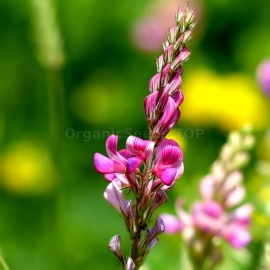





Sainfoin Organic Seeds (Onobrychis Viciifolia)
1.14 €
Introduced, perennial, nitrogen-fixing legume with stout, erect to nearly-erect, hollow, succulent stems, up to 4 ft. in height. Sainfoin is quickly gaining popularity in the U.S. and Canada as a non-bloat forage alternative to alfalfa.
-
Organic Sainfoin (Onobrychis Viciifolia)
Introduced, perennial, nitrogen-fixing legume with stout, erect to nearly-erect, hollow, succulent stems, up to 4 ft. in height. Sainfoin is quickly gaining popularity in the U.S. and Canada as a non-bloat forage alternative to alfalfa.
Extremely palatable and highly nutritious to all types of livestock and wildlife, with digestibility equal to alfalfa. Grow for high-protein hay, pasture or silage in either pure stands or as a component of grass mixtures. Also use for habitat enhancement or in wildlife food plots.
Excellent pollinator species and a superior honey plant to alfalfa. It is both drought-tolerant and winter-hardy. Neither invasive or weedy. Matures faster than alfalfa, providing early spring forage.
Sowing method and time
Sainfoin seed should be drilled as it is relatively large. It may be planted with a narrow spaced drill (10-14 cm) or cross drilled in wider rows. Seed can be sown in spring, where it may be undersown to a low rate cereal (100 kg/ha) or in summer/autumn provided there is sufficient moisture. In cold regions, autumn sowing is not recommended.
Grazing and conservation
Sainfoin provides bloat-free forage for ruminants and this is a real advantage over other legumes such as clovers and lucerne which can cause fatal bloat. Only a relatively small quantity of sainfoin in the diet is required to prevent bloat. Sainfoin is palatable to horses, sheep, cattle, goats and all commonly farmed animals. There is considerable concern that drug resistance is costing farmers serious economic loss accross Europe. Sainfoin is proven to be anthelminitic which is useful to reduce the routine use of expensive wormers.
Sainfoin is considered to be one of the healthiest forage plants available and this is demonstrated by many livestock breeders who choose to grow the crop. It has a 25% higher voluntary intake than grasses and clovers and provides greater liveweight gain than grasses and clovers too. In sheep for example it is possible to acheive in excess of 400gms per day. This is thought to be due to the tannins which the plant contains which protect the protein, enabling it to pass through the rumen and into the lower gut where more is digested and used by the animal.
Silage and hay is made in the same way as for other crops. The only differences are that the mown material needs handling carefully as it dries so as to minimise leaf loss, especially during hay making. When made into silage it is best to use an additive/inoculant to kick start the fermentation process. Farmers wishing to make silage should wilt to around 50% dry matter.
Livestock farmers are increasingly under pressure to reduce the methan produced by their ruminant animals. Work currently being undertaken shows that sainfoin may cut the emmisions of this dangerous greenhouse gas.
Sainfoin may be included in seed mixtures in the same way as clovers are grown with grasses. A typical inclusion rate would be 12 kg/ha.
